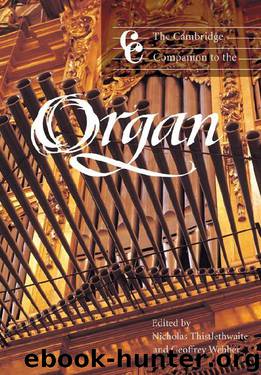The Cambridge Companion to the Organ (Cambridge Companions to Music) by Nicholas Thistlethwaite & Geoffrey Webber

Author:Nicholas Thistlethwaite & Geoffrey Webber [Thistlethwaite, Nicholas & Webber, Geoffrey]
Language: eng
Format: epub
Publisher: Cambridge University Press
Published: 1999-03-04T03:00:00+00:00
The capriccio
The word ‘capriccio’ was used as a generic term for keyboard pieces in the title of publications by Mayone and Trabaci. It was also used for compositions of a basically polyphonic nature, having much in common with the ricercar, fantasia and canzona, but usually treating one subject only. Outstanding examples include de Macque’s Capriccio sopra re fa mi sol and Frescobaldi’s 1624 set.
The Toccata
In order to establish the mode before a vocal work was sung, the church organist would play. As we know from the lutenist Dalza’s ‘tastar de corde’, secular vocal or instrumental music was similarly introduced. Andrea Gabrieli’s Intonationi are mini-toccatas intended to serve this purpose. Giovanni Gabrieli’s set consists of pieces that are even shorter. The book in which Giovanni published all these Intonationi in 1593 also contains three of Andrea’s toccatas.
Marc’ Antoni’s Recerchari discussed above are perhaps to all intents and purposes toccatas. The manuscript example which begins in mode III and finishes in mode I may well have been designed for liturgical use as a bridge between vocal items sung in these two modes. It is conceivable that the longer printed Recerchari were also used in this way by simply terminating at an intermediate cadence rather than playing from beginning to end – an approach sanctioned by Frescobaldi in the introduction to his books of toccatas a century later. The modulatory nature of Cavazzoni’s pieces would seem to support this hypothesis. While these large-scale pieces, like some of Giovanni Gabrieli’s toccatas (see especially that in mode I), appear to have been conceived for the ripieno of a large Renaissance organ, the intricate passagework of Claudio Merulo’s toc-catas suggest a smaller instrument – perhaps a 4′ organ or a harpsichord or even a combination of the two: claviorganum.8 The texture of these works is often that of a solo part – reminiscent of virtuoso passaggi written for a solo instrument such as a cornet or a viol – which passes from one hand to the other, while the free hand provides accompanying chords in the nature of a continuo realisation. For contrast, Merulo introduces imitative polyphonic sections into his toccatas. That these should be played more slowly, with respect to the written note-values, than the free-style sections is suggested by the fact that a manuscript version has minims in such sections where the print has crochets (see Example 10.3). The same manuscript often omits such polyphonic sections entirely; this could, like Frescobaldi’s suggested curtailing of his toccatas, be the result of an accepted tradition which treated compositions in a slightly cavalier fashion not so acceptable to later generations – on the other hand, these omissions might well reflect earlier versions of Merulo’s toccatas, the polyphonic sections being perhaps added at a later stage. Comparison of two versions of the Toccata Ottava from Merulo’s second book (Rome 1604), seen in Example 10.3, show how the composer developed passaggi, or perhaps simply provided more notes in the print reflecting what his students would have added when playing from the simpler manuscript version.
Download
This site does not store any files on its server. We only index and link to content provided by other sites. Please contact the content providers to delete copyright contents if any and email us, we'll remove relevant links or contents immediately.
The Goal (Off-Campus #4) by Elle Kennedy(13213)
Kathy Andrews Collection by Kathy Andrews(11346)
Diary of a Player by Brad Paisley(7272)
What Does This Button Do? by Bruce Dickinson(5938)
Assassin’s Fate by Robin Hobb(5867)
Big Little Lies by Liane Moriarty(5528)
Altered Sensations by David Pantalony(4878)
Pale Blue Dot by Carl Sagan(4633)
Sticky Fingers by Joe Hagan(3918)
The Death of the Heart by Elizabeth Bowen(3350)
The Heroin Diaries by Nikki Sixx(3328)
Beneath These Shadows by Meghan March(3158)
Confessions of a Video Vixen by Karrine Steffans(3110)
The Help by Kathryn Stockett(3024)
How Music Works by David Byrne(2969)
Jam by Jam (epub)(2882)
Harry Potter 4 - Harry Potter and The Goblet of Fire by J.K.Rowling(2818)
Strange Fascination: David Bowie: The Definitive Story by David Buckley(2704)
Petty: The Biography by Warren Zanes(2579)
